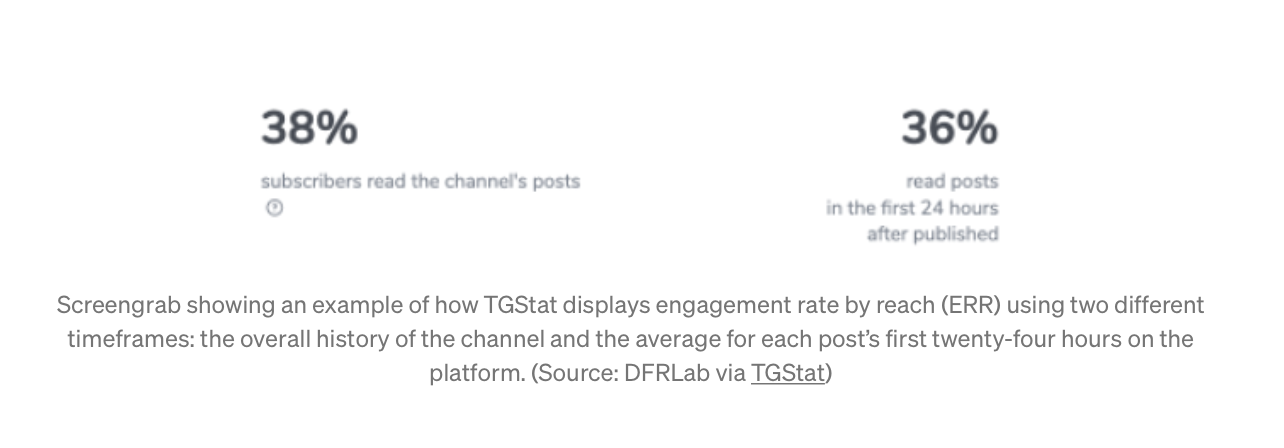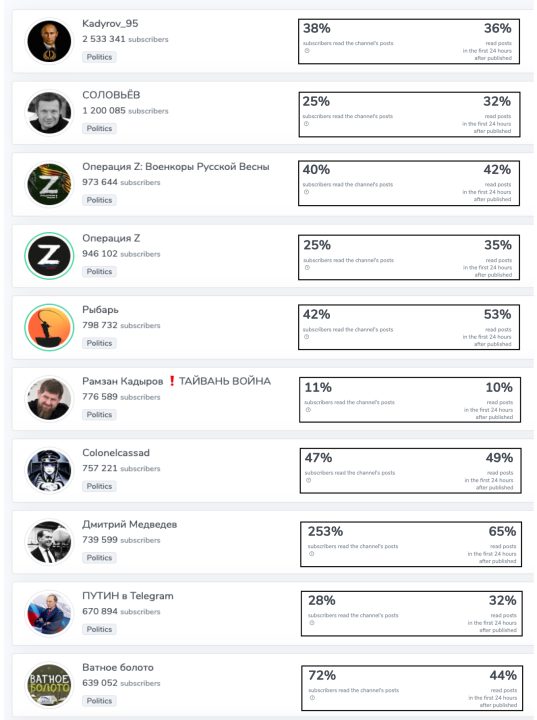What Russia reads on Telegram
Nine out of the top ten political Telegram channels in Russia spread Kremlin pro-war propaganda
What Russia reads on Telegram

BANNER: Nine out of the top ten political Telegram channels in Russia spread Kremlin pro-war propaganda
Since Russia’s February 2022 invasion of Ukraine, Telegram has emerged as a significant information battlefield where the Kremlin and pro-Kremlin actors spread disinformation and propaganda about the war. In Russia, nine of the ten most popular political Telegram channels spread Kremlin pro-war narratives, according to a DFRLab analysis using the tool TGStat.
Telegram has become one of the most important informational vectors regarding the war. In August 2022, Forbes.ru documented a sharp increase in the usage of Telegram in Russia starting in March, while simultaneously noting decreases in Instagram and Facebook usage. According to the Wall Street Journal, nearly a quarter of Russia’s population uses Telegram. Even though Russia has blocked some Western online platforms and currently continues its effort to silence others, Russian citizens regularly use virtual private networks (VPNs) to circumvent official bans and access content in the West.
Telegram in Russia
Forbes.ru outsourced a study calculating the daily audience of the most popular social networks in Russia to Mediascope, a Russian media research and monitoring company. The research found that Telegram benefited the most from Russia’s move to block Western online platforms, as its daily audience in Russia grew by 66 percent over a six-month period, from 25 million in January 2022 to 41.5 million people in July 2022. According to Forbes.ru, the majority of this upsurge happened in March, when the audience increased from 27.5 million users in February to 40.6 million in March. That same month, Russia passed a law that could imprison a person for fifteen years for spreading “fakes” about the Russian army; this led to multiple media entities terminating their work in the country.
The DFRLab observed increased Russian interest in Telegram using a Google Trends query that showed a significant spike in Russia-based user searches for “Telegram” and the Russian equivalent “Телеграм” in March 2022. Since then, searches of the terms remained higher than pre-war levels.

Additionally, Yandex Keyword Statistics, which shows user interest in specific topics on Russia’s most popular search engine, also recorded an increase in interest in Telegram March. According to Yandex data, searches for Telegram spiked at the beginning of that month; like the Google Trends data, it remains higher than pre-war levels.

Meanwhile, Russia was in first place among countries sending traffic to Telegram’s website from July through September 2022, according to a DFRLab query conducted on website analytics tool SimilarWeb. It also showed that in August, two of the five most popular search topics on the Telegram website were “news” and its Russian language equivalent, “новости.”


The top ten political Telegram channels in Russia
Given how Telegram became a go-to platform during Russia’s invasion of Ukraine, numerous official and anonymous sources use the group messaging app to share Kremlin narratives. As the Kremlin has not blocked Telegram, Russian citizens do not have to use VPN services to access the platform.
Using the Russia-based Telegram analysis tool TGStat, the DFRLab analyzed the top ten political Telegram channels in Russia. Ranked by number of subscribers, nine out of the ten channels are pro-Kremlin, and use their channels to spread pro-war propaganda and disinformation.

For each of these channels, the DFRLab analyzed engagement rate by reach (ERR), which is calculated by dividing the average number of views for a channel’s posts by the number of channel subscribers and then presented as a percentage. Not every post to a channel will be widely read by its members, resulting in low engagement, while in other cases a channel’s posts become so popular on other channels that post views exceed the number of subscribers to the channel itself. ERR captures this level of engagement in both contexts.
TGStat provides information on two kinds of ERR: a channel’s overall ERR and an ERR dedicated to measuring the first twenty-four hours of each post’s existence. Measuring overall ERR is useful to get a sense of long-term engagement trends on a channel, while ERR focusing on the first twenty-four hours of a post sheds light on a channel’s ability to receive engagement while posts are still fresh. An ERR level above 100 percent represents situations in which a channel’s posts manage to garner views on multiple Telegram channels that exceed the number of subscriber on the channel that posted it.

According to TGStat, the overall ERRs for the top ten political channels in Russia range from a low of 11 percent to a high of 253 percent. When it calculated ERR for readership within 24 hours of a post being published, results ranged from a low of 10 percent to 65 percent. In both cases, the lowest ERR values were associated with an unofficial channel supporting Chechen leader Ramzan Kadyrov, while the highest values came from the official channel of former Russian President and Prime Minister Dmitry Medvedev.

What the top ten Telegram channels are posting
Among the ten most popular political Telegram channels in Russia, the top nine can be categorized as pro-Kremlin, as they routinely spread Kremlin narratives, Russian disinformation and pro-war propaganda.
The top two channels, Kadyrov_95 and СОЛОВЬЁВ (“SOLOVIEV”), belong to Chechen leader Ramzan Kadyrov and Kremlin propagandist Vladimir Soloviev respectively. Kadyrov has long cultivated his personal brand across multiple social media platforms and is known for his loyalty to Putin, while Soloviev’s television show, “Evening with Vladimir Soloviev,” is among the most influential in the country. Kadyrov’s channel is by far the largest on the list; with more than three million subscribers, it has more than twice as many members as Soloviev’s second-place channel, which at the time of writing had more than 1.3 million subscribers.
![Ramzan Kadyrov’s channel now has more than three million members. The Russian text translates to “Love the Prophet [Muhammad], Peace Be Upon Him!”](https://dfrlab.org/wp-content/uploads/sites/3/2022/10/Screenshot-2022-10-21-at-18.14.36-701x720.png)
The third and fourth most popular political Telegram channels, Операция Z: Военкоры Русской Весны (“Operation Z: Military Correspondents of the Russian Spring”) and Операция Z (“Operation Z”), are run anonymously, and both prominently feature the Russian “Z” symbol, which has become synonymous with support for the invasion. It is also worth noting that Операция Z is the only channel in the top ten that is private, requiring users to request access before being allowed to read the channel. The channel name and its accompanying description, the pro-war slogan своих не бросаем (“We don’t leave ours [behind]”), both communicate the group’s support of Kremlin war efforts. The fifth channel, Рыбарь (“The Fisherman”), is also anonymous and spreads Kremlin propaganda.

The sixth channel, Рамзан Кадыров ❗️ТАЙВАНЬ ВОЙНА (“Ramzan Kadyrov ❗️ TAIWAN WAR”), is run anonymously, and acknowledges that it is not an official Kadyrov channel. The channel had the lowest ERR percentages of all the channels in the top ten. Its posts are aligned with Kadyrov and his pro-Kremlin stance. In seventh place is Colonelcassad, a channel belonging to Kremlin military commentator Boris Rozhin.
In eighth place is the official channel of former Russian President and Prime Minister Dmitry Medvedev, who currently serves as deputy chair of Russia’s Security Council. As noted earlier, his channel has the highest ERR levels among the top ten, with posts routinely going viral across Russian Telegram. The ninth channel, ПУТИН в Telegram (“PUTIN on Telegram”), is not formally affiliated with the Russian president but heavily promotes his policies and leadership.
The last channel on the top ten list is the only one that is not pro-Kremlin. Ватное болото (“Cotton Swamp”) describes itself as “the most read opposition channel on Telegram.” It publicly lists the usernames of its seven administrators and coordinators but does not provide further details about their identities. The channel publishes anti-Kremlin posts, as well as memes and entertaining content mocking the Kremlin.
Cite this case study:
Eto Buziashvili, “What Russia reads on Telegram,” Digital Forensic Research Lab (DFRLab), October 21, 2022, https://medium.com/dfrlab/what-russia-reads-on-telegram-a45d90e3bdc1.

